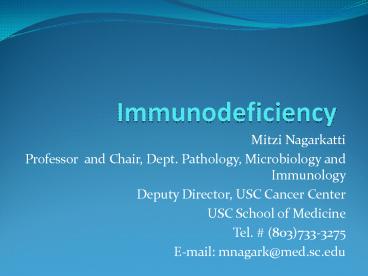Immunodeficiency - PowerPoint PPT Presentation
1 / 24
Title:
Immunodeficiency
Description:
RAG=Recombinase activating gene defect (SCID) CD4. Btk. Ag. IL-2, 4, ... Recombinase activating gene (RAG-1 and 2) (T and B ... replication (109 viruses/day) ... – PowerPoint PPT presentation
Number of Views:148
Avg rating:3.0/5.0
Title: Immunodeficiency
1
Immunodeficiency
- Mitzi Nagarkatti
- Professor and Chair, Dept. Pathology,
Microbiology and Immunology - Deputy Director, USC Cancer Center
- USC School of Medicine
- Tel. (803)733-3275
- E-mail mnagark_at_med.sc.edu
2
Outline
- Common Primary Immunodeficiencies
- Acquired Immunodeficiency (HIV)
- Therapy and prevention of AIDS
3
Immunodeficiency
- Defect in 1 or more components of immune system
- Types
- Primary Mutation in genes controlling immune
system - (e.g. Recurrent, severe infection in children)
- Secondary Acquired as a consequence of other
diseases or environmental factors - (e.g. infection, malignancy, aging, starvation,
medication, drugs)
4
Primary Immunodeficiencies
Stem Cell
Reticular Dysgenesis
Lymphoid Progenitor
Myeloid Progenitor
Severe combined Immunodeficiency SCID
Congenital Agranulocytosis
Pre-B
Monocyte
Pre-T
Neutrophil
x-linked agglobulinemia xLA
Mature B
Thymus
Leukocyte Adhesion Deficiency
DiGeorge Syndrome D
Chronic Granulomatous Disease (x or D)
Mature T
Plasma Cell
Memory B
WAS
Common Variable Hypogglobulinemia / x-linked
hyperIgM syndrome/Selective Ig deficiency
WASWiskott- Aldrich Syndrome x
Bare Lymphocyte Syndrome
5
DiGeorge syndrome
3rd and 4th pharyngeal pouch
6
Defects in T cell-B cell interactions
BtkBruton tyrosine kinase Defect (XLA)
IL-2Rg defect
IL-2Rg
IL-2, 4, 7, 9, 15
B
J
Btk
XHM
CD40
CD40L
JAK3 defect
Ag
JAK-3
RAG 1/2
Ag
RAG1/2
MHC II
TCR
Ig
Bare Lymphocyte Syndrome (MHC II- ve)
CD4
T cell
B cell
RAGRecombinase activating gene defect (SCID)
JAKJanus kinase
7
Adaptive Immunity Deficiency
- T cell deficiency
- Susceptible to intracellular bacterial infection
- Susceptible to viral, parasitic and fungal
infection - B cell deficiency
- Susceptible to extracellular bacterial infection
- Severe Combined Immunodeficiency Disease (SCID)
- T and B cell functions defective
- Usually fatal
- Transplacental/milk transmission of Abs
- TCR gene rearrangement lacking
- Myeloid and erythroid components intact
8
Nude Athymic mouse
9
Immunodeficiencies
- IL-2Rg Common Chain deficiency (IL-2, 4, 7, 9 and
15 signaling) - Adenosine Deaminase (ADA deficiency)
- ADA
- Adenosine--------?Inosine
- (T, B and NK cell deficiency)
- Recombinase activating gene (RAG-1 and 2)
- (T and B cell deficiency)
10
Secondary or Acquired Immunodeficiencies
- Agent-induced immunodeficiency e.g. infections,
metaboic disturbance, trauma, corticosteroids,
cyclosporin A, radiation, chemotherapy - Acquired Hypogammaglobulinemia (Low levels of Ig
recurrent infections treat with Ig)
11
Human Immunodeficiency Virus
- Discovered in 1983
- Luc Montagnier and Robert Gallo
- Retrovirus
- HIV-1 and HIV-2
- Patients with low CD4 T cells
- Homosexual promiscuous heterosexual, i.v. drug
users transfusion infants born to infected
mothers - Opportunistic infections with Pnuemocystis
carinii, Candida albicans, Mycobacterium avium,
etc. - Kaposi sarcoma
12
Kaposi Sarcoma
13
Acquired Immunodeficiency Syndrome (AIDS)
Structure of HIV-1
gp120
env
gp41
Protease
Envelope
Reverse Trascriptase
pol
Integrase
Matrix (p17)
gag
Capsid (p24)
Genome
14
HIV Infection
Coreceptors Chemokine receptors T cell-tropic
(Syncitium-inducing)
CXCR4 SDF1 (Stromal cell derived factor)
gp120
CD4
Provirus
ssRNA
Macrophage-tropic (Nonsyncitium inducing)
Reverse transcriptase
CCR5 RANTES (regulated on activation, normal T
cell expressed and Secreted), MIP1a, MIP1b
(Macrophage Inflammatory Protein)
dsDNA
15
Serological Profile
Kuby, 2007
16
Immunological Abnormalities
- Infection and destruction of dendritic cells,
macrophages and Th cells - Late decrease in Th cell numbers (200/mm3 blood)
17
Virus-induced effects on immune cells
- Th Cells
- Initially control viral load
- Destruction of infected Th cells by CTL
- Cytopathic virus
- Anergy of surviving Th cells
- CTL
- gp120 specific CTL
- Virus mutation induces resistance to CTL
- Lack of Th affects CTL activation
- Resistance to CTL by downregulation of class I
MHC on target cells - Ab
- Develops after 3 weeks
- Virus Agic variability
- Non-neutralizing. Thus, ineffective
18
Host Factors influencing course
- Transmission of HIV
- Sexual contact
- Breast feeding
- Transfusion
- During birth
- Sharing needles
- Resistance to HIV in individuals
- CCR5D32
- Some HLA types (HLA-A2 are resistant HLA-B35 are
susceptible)
19
Animal Models
- Primate Model
- HIV grows in chimpanzees but do not develop AIDS
- Simian immunodeficiency virus (SIVagm in African
green monkey no disease SIVmac in Macaques
AIDS like) Feline immunodeficiency virus (FIV),
etc. - Mouse Model
- Grows in Severe Combined Immunodeficiency (SCID)
mice reconstituted with human lymphocytes
20
Therapeutic targets
Kuby, 2007
21
Therapy
- Reverse Transcription Inhibitors
- Nucleoside RT inhibitors e.g. Zidovudine or AZT
(azidothymidine) - Non-nucleoside RT inhibitors e.g. nevirapine
(Inhibit RT) - Protease inhibitors (proteases cleave precursor
proteins into proteins that are needed for virion
assembly) - Integrase inhibitors (integration of provirus in
the cell DNA e.g. ritonavir) - Entry/Fusion inhibitors e.g. enfuvirtide
- HAART (Highly active anti-retroviral therapy)
combination - Problems
- Anemia
- Virus in brain
- Antigenic variation
- BBB not penetrated by drugs
- High costs (15K/yr)
22
Immunomodulation
- HAART IL-2 (To reconstitute the immune system)
- Chemokine receptor inhibitors
- Vaccines Proteins, DNA, subunit and recombinant
virus (SIV-HIV chimeric virus ) - Problems
- HIV-1 inf. -gt AIDS in the presence of Abs
- Low immunogenicity
- Destruction of CD4 T cells by vaccine
- Integration of virus in host genome
- Instability of HIV-1 genome
- High rate of virus replication (109 viruses/day)
- Live attenuated or heat killed organism (vaccinia
virus carrier for HIV proteins) - Route of exposure (Rectal or vaginal challenge)
- Lack of animal models and in vitro testing system
23
Summary
- Primary immunodeficiencies are inherited
- They can affect hematopoietic stem cells,
lymphoid or myeloid cells. - Secondary immunodeficiencies are due to
infections, aging, cancer or chemical exposure - HIV affects immune system by eliminating CD4 T
cells - Vaccine development has been hindered by lack of
an experimental model, antigenic variation, etc.
24
Reading
- Immunology
- By Male, Brostoff, Roth and Roitt
- 7th Edition
- Pages299-324































